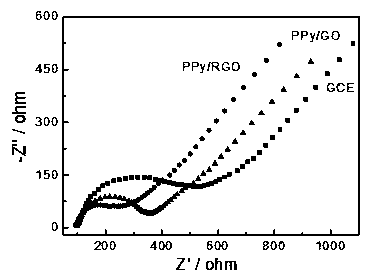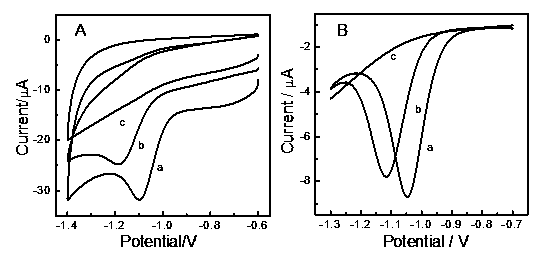Electrochemical detection method for pesticide imidacloprid based on polypyrrole/reduced graphene oxide (PPy/RGO) modified glassy carbon electrode
A glassy carbon electrode and detection method technology, applied in the field of electrochemical analysis and detection, can solve the problems of complex preparation of modified glassy carbon electrodes, and achieve the effects of fast electron transfer rate, low detection limit, and large electroactive area
- Summary
- Abstract
- Description
- Claims
- Application Information
AI Technical Summary
Problems solved by technology
Method used
Image
Examples
Embodiment 1
[0024] The electrochemical detection method of imidacloprid by PPy / RGO modified glassy carbon electrode is characterized in that, comprising the following steps:
[0025] (1) Preparation of polypyrrole / reduced graphene oxide modified glassy carbon electrode (PPy / RGO): Add 10 μL of pure pyrrole monomer dropwise to 10 ml of graphene oxide dispersion with a concentration of 1 mg / mL, and then sonicate for half an hour , to obtain a mixed solution containing pyrrole monomer and graphene oxide. The clean and prepared glassy carbon electrode was placed in the mixed solution, and the potential range was -0.2 ~ 1.0 V. Cyclic voltammetry polymerization was performed for 10 cycles, and the scan rate was 100 mV / s to obtain a polypyrrole / graphene oxide modified glassy carbon electrode. The obtained polypyrrole / graphene oxide modified glassy carbon electrode was placed in a phosphate buffer solution with pH = 7, and the potential range was 0 ~ -1.7 V. Cyclic voltammetry was scanned for 10 c...
Embodiment 2
[0035] The electrochemical detection method of imidacloprid by PPy / RGO modified glassy carbon electrode is characterized in that, comprising the following steps:
[0036] (1) Preparation of polypyrrole / reduced graphene oxide modified glassy carbon electrode (PPy / RGO): Add 15 μL of pure pyrrole monomer dropwise to 10 ml of graphene oxide dispersion with a concentration of 5 mg / mL, and then ultrasonically hours, a mixed solution containing pyrrole monomer and graphene oxide was obtained. The clean prepared glassy carbon electrode was placed in the mixed solution, the potential range was -0.2 - 1.0 V, cyclic voltammetry polymerization was performed for 5 cycles, and the scan rate was 100 mV / s, and the polypyrrole / graphene oxide modified glassy carbon electrode was obtained. The obtained polypyrrole / graphene oxide modified glassy carbon electrode was placed in a phosphate buffer solution with pH = 7, and the potential range was 0 ~ -1.7 V. Cyclic voltammetry was scanned for 5 cycl...
Embodiment 3
[0040] The electrochemical detection method of imidacloprid by PPy / RGO modified glassy carbon electrode is characterized in that, comprising the following steps:
[0041] (1) Preparation of polypyrrole / reduced graphene oxide modified glassy carbon electrode (PPy / RGO): Add 20 μL of pure pyrrole monomer dropwise to 10 ml of graphene oxide dispersion with a concentration of 0.5 mg / mL, and then sonicate After half an hour, a mixed solution containing pyrrole monomer and graphene oxide was obtained. The clean prepared glassy carbon electrode was placed in the mixed solution, the potential range was -0.2 ~ 1.0 V, cyclic voltammetry polymerization was performed for 30 cycles, and the scan rate was 100 mV / s, and the polypyrrole / graphene oxide modified glassy carbon electrode was obtained. The obtained polypyrrole / graphene oxide modified glassy carbon electrode was placed in a phosphate buffer solution with pH = 7, and the potential range was 0 ~ -1.7 V. Cyclic voltammetry was scanned ...
PUM
 Login to View More
Login to View More Abstract
Description
Claims
Application Information
 Login to View More
Login to View More - R&D
- Intellectual Property
- Life Sciences
- Materials
- Tech Scout
- Unparalleled Data Quality
- Higher Quality Content
- 60% Fewer Hallucinations
Browse by: Latest US Patents, China's latest patents, Technical Efficacy Thesaurus, Application Domain, Technology Topic, Popular Technical Reports.
© 2025 PatSnap. All rights reserved.Legal|Privacy policy|Modern Slavery Act Transparency Statement|Sitemap|About US| Contact US: help@patsnap.com



